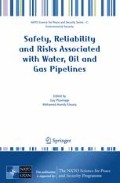The temperature influence on mechanical properties of the carbon steels is discussed. Under high temperatures the steel structures, moreover the pipes, can lose their structural strength.
Access this chapter
Tax calculation will be finalised at checkout
Purchases are for personal use only
Preview
Unable to display preview. Download preview PDF.
References
N. I. Nikitenko and N. R. Snovida, The temperature dependence of Poisson’s ratio and its influence on solids stress condition. Teplofizika I Teplotekhnika, No. 29, 38-41 (1975) (in Russia).
I. E. Prokopowich, Influence of long-term processes on construction stress and deformation conditions (Gosstrojizdat, 1963) (in Russian).
N. I. Bezukhov, N. I. Bajanov, I. I. Goldenblat, N. A. Nikolajenko, and A. M. Sinjukov, Durability, stability and vibration calculation in high temperature environment (Mashinostroenie Moscow, 1965), pp. 567 (in Russian)
S. A Golovin, A. A. Morozjuk, et al., Plant for steel Young modulus measurement under high temperature, in Book Vzaimodejstvie defektov kristallicheskoj reshotki I svojstva metallov, Tula, pp. 90-93 (1980) (in Russian).
N. N. Guglin, A. A. Novikova, and B. B. Guljaev, Study of mechanical properties of steels under temperature near-crystallization point, Kristalizatsija metallov, 126-134 (1960) (in Russian).
E. A. Leonova, Mechanical properties of steels about a crystallization temperature, Uprugost I neuprugost, No. 1, 221-250 (1971) (in Russian).
Tetsu to Hagane. Influence of copper, tin and sulfur on mechanical properties of 0.25% carbon steal under high temperatures, 66, No. 4, 170 (1980) (in Russian).
L. I. Morozinski and O. A. Mitaev, Physicochemical and thermal-physic processes of bar steel crystallization, Tr. II konferentsii po slitkam, 438-447 (in Russian).
O. P. Puringer, Forming of uninterruptedly-casted feedworks, Chornie metallic, 6-7, 3-8 (1967)
A. Ghali and E. Elliott, Pre stressing of circular tanks, ACI Structural Journal, 88, No. 6, 721-729 (1991).
V. L. Yefimov, Steel pouring and crystallization, Metallurgia, Moscow, 552 (1976) (in Russian).
L. M. Muradyan, The plane problem of thermal creep under high temperatures, DAN. ArmSSR, LIV, No. 1, 74-85 (1972).
Yu. N. Rabotnov, Creep of construction element (Moscow, Nauka, 752, 1966) (in Russian).
S. A. Shesterikov et al., Rules of creep and long-term durability (Moscow, Mashinostroenie, 101, 1983) (in Russian).
A. A. Ilushin and B. E. Pobedria, Mathematical fundamentals of thermoviscoelastic theory (Moscow, Nauka, 280, 1970) (in Russian).
L. M. Kachanov, The theory of creep (Fizmatgiz, Moscow, 455, 1960) (in Russian).
I. I. Goldenblat et al., Structural analysis on thermal effects (Moscow, 566, 1969) (in Russian).
F. K. G. Odqvist, Mathematical theory of creep and creep rupture (Oxford, Clazendon Press, 1974).
F. Garofalo, Fundamentals of creep and creep-rupture in metals (New York, 1965).
S. A. Shesteriklov and A. M. Lokoshchenko, Creep and long-term stability of steels, in Book Itogi nauki I tekhniki. Ser.Mekh. def.tverd.tela, 13, 3-186 (1980) (in Russian).
Yu. N. Rabotnov and S. T. Mileyko, Short-term creep (Moscow, 222, 1970) (in Russian).
K. Sorimachi and I. K. Brimocomba, Improvements in mathematical modeling of stress in continuous casting of steel, Ironmaking and Steelmaking, 4, 240-245 (1977).
V. K. Adamovich, I. I. Mints, and R. V. Yancer, About the nature of temperature-time parameters used during prediction of long-term stability steels and alloys, Problemi prochnosti., No. 1, 34-38, (1976) (in Russian).
L. M. Muradyan and V. A. Vardanyan, About carbon steels creep under high temperatures, Izvestia AN ArmSSR, ser. tekh. Nauk, TXLIV, No. 4 (1991) (in Russian).
S. A. Palmers, Mechanical properties of steels under high temperature as a checker of continuous casting, Met. oboz., 53, 23-32 (1978) (in Russian).
H. Fudzi, M. Oda, et al., Steel plasticity near-crystallization temperature, Tetsu to Hagane, 68, No. 14, 2148-2157 (in Russian).
R. N. Barsegyan, Thermal stress condition of hollow cylindrical shell with liquid nardening core, Dis… kandid. Tekh. Nauk, YrPhI, Yerevan, 99 (1985) (in Russian).
Author information
Authors and Affiliations
Editor information
Editors and Affiliations
Rights and permissions
Copyright information
© 2008 Springer
About this paper
Cite this paper
Barseghyan, R., Barseghyan, A. (2008). Deformation Characteristics of Carbon Steels Under High Temperatures. In: Pluvinage, G., Elwany, M.H. (eds) Safety, Reliability and Risks Associated with Water, Oil and Gas Pipelines. NATO Science for Peace and Security Series. Springer, Dordrecht. https://doi.org/10.1007/978-1-4020-6526-2_18
Download citation
DOI: https://doi.org/10.1007/978-1-4020-6526-2_18
Publisher Name: Springer, Dordrecht
Print ISBN: 978-1-4020-6524-8
Online ISBN: 978-1-4020-6526-2
eBook Packages: Chemistry and Materials ScienceChemistry and Material Science (R0)

